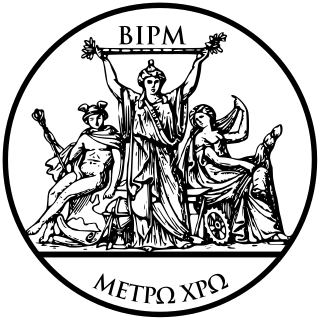
The International Bureau of Weights and Measures is an intergovernmental organisation, through which its 59 member-states act on measurement standards in areas including chemistry, ionising radiation, physical metrology, as well as the International System of Units (SI) and Coordinated Universal Time (UTC). It is based in Saint-Cloud, near Paris, France. The organisation has been referred to as IBWM in older literature.
The General Conference on Weights and Measures is the supreme authority of the International Bureau of Weights and Measures (BIPM), the intergovernmental organization established in 1875 under the terms of the Metre Convention through which member states act together on matters related to measurement science and measurement standards. The CGPM is made up of delegates of the governments of the member states and observers from the Associates of the CGPM. It elects the International Committee for Weights and Measures as the supervisory board of the BIPM to direct and supervise it.

The inch is a unit of length in the British Imperial and the United States customary systems of measurement. It is equal to 1/36 yard or 1/12 of a foot. Derived from the Roman uncia ("twelfth"), the word inch is also sometimes used to translate similar units in other measurement systems, usually understood as deriving from the width of the human thumb.

The imperial system of units, imperial system or imperial units is the system of units first defined in the British Weights and Measures Act 1824 and continued to be developed through a series of Weights and Measures Acts and amendments.

The kilogram is the base unit of mass in the International System of Units (SI), having the unit symbol kg. 'Kilogram' means 'one thousand grams' and is colloquially abbreviated to kilo.

Measurement is the quantification of attributes of an object or event, which can be used to compare with other objects or events. In other words, measurement is a process of determining how large or small a physical quantity is as compared to a basic reference quantity of the same kind. The scope and application of measurement are dependent on the context and discipline. In natural sciences and engineering, measurements do not apply to nominal properties of objects or events, which is consistent with the guidelines of the International vocabulary of metrology published by the International Bureau of Weights and Measures. However, in other fields such as statistics as well as the social and behavioural sciences, measurements can have multiple levels, which would include nominal, ordinal, interval and ratio scales.

Metrication or metrification is the act or process of converting to the metric system of measurement. All over the world, countries have transitioned from local and traditional units of measurement to the metric system. This process began in France during the 1790s, and has persistently advanced over two centuries, accumulating into 95% of the world officially only using the modern metric system. Nonetheless, this also highlights that certain countries and sectors are either still transitioning or have chosen not to fully adopt the metric system.

The pound or pound-mass is a unit of mass used in both the British imperial and United States customary systems of measurement. Various definitions have been used; the most common today is the international avoirdupois pound, which is legally defined as exactly 0.45359237 kilograms, and which is divided into 16 avoirdupois ounces. The international standard symbol for the avoirdupois pound is lb; an alternative symbol is lbm, #, and ℔ or ″̶.

The SI base units are the standard units of measurement defined by the International System of Units (SI) for the seven base quantities of what is now known as the International System of Quantities: they are notably a basic set from which all other SI units can be derived. The units and their physical quantities are the second for time, the metre for length or distance, the kilogram for mass, the ampere for electric current, the kelvin for thermodynamic temperature, the mole for amount of substance, and the candela for luminous intensity. The SI base units are a fundamental part of modern metrology, and thus part of the foundation of modern science and technology.

Metrology is the scientific study of measurement. It establishes a common understanding of units, crucial in linking human activities. Modern metrology has its roots in the French Revolution's political motivation to standardise units in France when a length standard taken from a natural source was proposed. This led to the creation of the decimal-based metric system in 1795, establishing a set of standards for other types of measurements. Several other countries adopted the metric system between 1795 and 1875; to ensure conformity between the countries, the Bureau International des Poids et Mesures (BIPM) was established by the Metre Convention. This has evolved into the International System of Units (SI) as a result of a resolution at the 11th General Conference on Weights and Measures (CGPM) in 1960.

Chinese units of measurement, known in Chinese as the shìzhì, are the traditional units of measurement of the Han Chinese. Although Chinese numerals have been decimal (base-10) since the Shang, several Chinese measures use hexadecimal (base-16). Local applications have varied, but the Chinese dynasties usually proclaimed standard measurements and recorded their predecessor's systems in their histories.

A bushel is an imperial and US customary unit of volume based upon an earlier measure of dry capacity. The old bushel is equal to 2 kennings (obsolete), 4 pecks, or 8 dry gallons, and was used mostly for agricultural products, such as wheat. In modern usage, the volume is nominal, with bushels denoting a mass defined differently for each commodity.
The slug is a derived unit of mass in a weight-based system of measures, most notably within the British Imperial measurement system and the United States customary measures system. Systems of measure either define mass and derive a force unit or define a base force and derive a mass unit. A slug is defined as a mass that is accelerated by 1 ft/s2 when a net force of one pound (lbf) is exerted on it.
English units were the units of measurement used in England up to 1826, which evolved as a combination of the Anglo-Saxon and Roman systems of units. Various standards have applied to English units at different times, in different places, and for different applications.
Traditional Japanese units of measurement or the shakkanhō (尺貫法) is the traditional system of measurement used by the people of the Japanese archipelago. It is largely based on the Chinese system, which spread to Japan and the rest of the Sinosphere in antiquity. It has remained mostly unaltered since the adoption of the measures of the Tang dynasty in 701. Following the 1868 Meiji Restoration, Imperial Japan adopted the metric system and defined the traditional units in metric terms on the basis of a prototype metre and kilogram. The present values of most Korean and Taiwanese units of measurement derive from these values as well.
Dimensional metrology, also known as industrial metrology, is the application of metrology for quantifying the physical size, form (shape), characteristics, and relational distance from any given feature.

A unit of measurement, or unit of measure, is a definite magnitude of a quantity, defined and adopted by convention or by law, that is used as a standard for measurement of the same kind of quantity. Any other quantity of that kind can be expressed as a multiple of the unit of measurement.

The imperial and US customary measurement systems are both derived from an earlier English system of measurement which in turn can be traced back to Ancient Roman units of measurement, and Carolingian and Saxon units of measure.
D. I. Mendeleev Institute for Metrology, previously known as the Main Chamber of Weights and Measures of the Russian Empire, or the Depot of Exemplary Measures and Weights, is one of the leading national metrology institutes of Russia now.
The Standards of Weights and Measures Act, 1976 was an Act of the Parliament of India enacted to establish standards of weights and measures, and to regulate trade or commerce in weights, measures, and other goods sold or distributed by weight, measure, or number. The Act aimed to ensure uniformity and accuracy in weights and measures across India.












